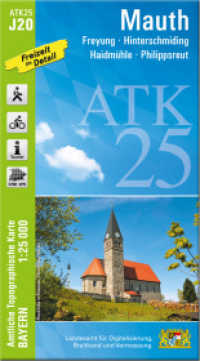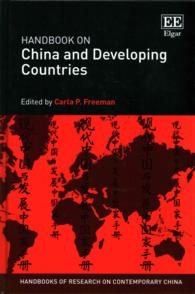- ホーム
- > 洋書
- > 英文書
- > Business / Economics
Full Description
This is an open access title available under the terms of a CC BY-NC-SA 3.0 IGO licence. It is free to read at Oxford Scholarship Online and offered as a free PDF download from OUP and selected open access locations.
Domestic Savings Shortfall in Sub-Saharan Africa aims to increase knowledge about the key drivers of domestic saving rates in Sub-Saharan Africa (SSA), as well as whether alternative approaches, such as pension funds or fintech, could provide new solutions to increase domestic savings. The book also examines the lessons learnt from the experiences so far in different countries in SSA, and what can SSA learn from the experience of other regions which have been more successful in raising savings rates.
The book consists of two parts: thematic studies and country studies. The thematic studies examine the implications of new developments in African financial markets on savings behaviour, the role of sovereign wealth funds, pensions, and capital markets in augmenting savings and in economic development, the challenges of the debt crisis in Africa, the implications of financial liberalization for private saving in SSA, and lessons on how to increase savings rates from East and South Asia. The four country studies-Tanzania, Cameroon, and Ghana-examine the determinants of domestic savings. The countries were selected based on criteria that capture the diversity of savings performance in SSA. Each case study uses a common conceptual framework drawn from the life-cycle theory of savings and the same empirical methods to test for the determinants of savings using time-series data for the country in question. The findings of the book provide clear recommendations on how to increase savings in Sub-Saharan Africa.
Contents
PART I: INTRODUCTION
1: Rose Ngugi and Kunal Sen: The domestic savings shortfall in sub-Saharan Africa: What are the key issues?
PART II: THEMATIC STUDIES
2: Njuguna Ndung'u: Fintech, savings, and financial inclusion in sub-Saharan Africa
3: Githinji Njenga, Josphat Machagua, and Samwel Gachanja: Accelerating capital markets development in sub-Saharan Africa
4: Owen Nyang'oro and Githinji Njenga: Old-age savings in sub-Saharan Africa
5: Tony Addison and Amir Lebdioui: Sovereign wealth funds in Africa
6: Maureen Were: Public debt challenges in sub-Saharan Africa
7: Elizabeth Asiedu, Fafanyo Asiseh, Theresa Mannah-Blankson, and Jones Arkoh Paintsil: The effects of financial liberalization on private savings in sub-Saharan Africa
8: Prema-chandra Athukorala and Wanessa Suanin: Economic growth and savings transition in Asia: Unity in diversity
PART III: COUNTRY STUDIES
9: Rodgers Musamali, Cecilia Mutia, and Rose Ngugi: Drivers of domestic saving in Kenya
10: Maureen Were and Cornel Joseph: Determinants of domestic savings in Tanzania
11: Charles Godfred Ackah and Monica Lambon-Quayefio: Understanding domestic savings in sub-Sahara Africa: A case study of Ghana
12: Abrams Tagem and Desiree Sama-Lang: The determinants of domestic savings in Cameroon
PART IV: CONCLUSION
13: Rose Ngugi and Kunal Sen: Conclusions and policy implications








